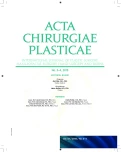A-01 RECONSTRUCTION OF DEFECTS WITH FOREHEAD FLAP
Authors:
Z. Dvořák 1,2; P. Novák 1; T. Výška 1; J. Veselý 1,2
Authors place of work:
Department of Plastic and Aesthetic Surgery St. Anne University Hospital Brno, Czech Republic
1; Medical Faculty, Masaryk University in Brno, Czech Republic
2
Published in the journal:
ACTA CHIRURGIAE PLASTICAE, 57, 3-4, 2015, pp. 46-48
Category:
Selected abstracts from the 36th national congress of the czech society plastic surgery with international participation
Introduction
Nose amputation was a common form of punishment in ancient India, where the caste of potters developed and improved the principle of nose reconstruction with a flap from the forehead. The actual spread of this method started only after the article of Carpue in the 19th century, who tried this method on 2 patients, after reading about it in a Gentlemen magazine from London.Traditionally has been used two stage nose reconstruction. Millard1 in 1974 proposed three stage concept of reconstruction, where he introduced another stage between transfer and division of the pedicle after 3 weeks, during which the thick skin at the tip of the nose was again reduced. This procedure was further modified by Burget and Menick2 who did not perform any initial thinning of the distal part of the flap, but all thinning was only performed after 3 weeks in the 2nd stage. The goal of this presentation is to evaluate the results of nose reconstruction with forehead flap at the Department of Plastic and Aesthetic Surgery in Brno and to demonstrate each technical finesses during construction of this flap.
Method
Retrospective study of 27 patients (14 men and 13 women), who underwent reconstruction of a nose defect with forehead flap within the period from 1.1.2007 to 30.6.2015. Recommended rules for construction of the flap are as follows:
- Forehead flap may have a pedicle on one side on the supratrochlear and supraorbital artery; thereby it is possible to construct two forehead flaps in each patient.
- Millard recommended gradual addition of another layer of the flap during elevation in the cranio-caudal direction; Menick, on the other hand, recommends elevation of the forehead flap in full thickness and to thin the flap in the second stage before detaching the pedicle.
- Thickness of the flap pedicle up to 2.5 cm provides direct closure of the defect on the forehead.
- In case of a low forehead, i.e. shorter than 7.5 cm, it is possible to turn the distal part of the flap along the hairline according to Burget.
- Donor site defect on the forehead is best to keep for secondary healing after approximation of the edges; in case of a large defect it is possible to use a skin graft from preauricular or retroauricular area.
- In patients with high risk of bleeding (disorder of coagulation, alcohol abuse), it is advantageous to split the skin bridge between donor and recipient area and suture in the edge of the pedicle of the flap.
- For planning of the shape of the flap, it is possible to use a template equivalent to the defect using a piece of fabric.
- For the area of collumela, it is advantageous to add a bit of tissue to reduce tension and ischemia in the particular area.
- It is not suitable to operate on patients after alcohol abuse.
- Metal clips on the forehead leave long term visible scars, therefore it is not suitable to use them.
- The time period between each step should be 3-4 weeks.
- The pedicle of the flap may be “trained” by strangulation.
- Flap on the forehead may be pre-expanded or prefabricated before transposition.
Results
The cause of nasal defect was 17x recurrent basalioma, 3x malignant melanoma, 2x spinalioma and in 5 cases was nose lost in alcohol abuse during a dog bite. In 27 patients were constructed 29 flaps, i.e. in 2 patients were constructed 2 flaps, but in both patients there was recurrence of tumor in time and subsequently it was necessary to perform extensive facial resection with free flap coverage. In five cases it was a one-stage flap, in other 24 cases it was two-stage flap with the need to detach the pedicle. The pedicle was usually kept for 37 days (13 - 159 days). Totally there were 26 corrections performed, some of them repeatedly, 2/3 of them due to correction of flap abundance. Complications occurred in 10 patients, 3x it was bleeding (11.1%), 1x partial necrosis (3.7%), 0x flap loss (0.0%), 1x flap infection (3.7%) and in five cases it was prolonged healing of the flap (18.5%).
Conclusion
At present times, forehead flap is a reliable, aesthetic and universal method to reconstruct larger nasal defects. An example of this fact is ideal quality, color and texture of forehead skin, reliability of the flap and aesthetically acceptable morbidity of donor area. Innovative may be considered three stage nasal reconstruction, because in our case also in the two stage reconstruction cases, most patients eventually came for correction of abundance of soft tissues in the nasal tip. (Fig. 1.1a, b, c.)

Zdroje
1. Millard DR. Reconstructive rhinoplasty for the lower half of a nose. Plast Reconstr Surg. 1974 Feb;53(2):133–9.
2. Menick FJ. A 10-year experience in nasal reconstruction with the three-stage forehead flap. Plast Reconstr Surg. 2002 May;109(6):1839–55; discussion 1856–61.
Štítky
Chirurgie plastická Ortopedie Popáleninová medicína TraumatologieČlánek vyšel v časopise
Acta chirurgiae plasticae

2015 Číslo 3-4
- Metamizol jako analgetikum první volby: kdy, pro koho, jak a proč?
- MUDr. Lenka Klimešová: Multioborová vizita může být klíčem k efektivnější perioperační léčbě chronické bolesti
- Léčba akutní pooperační bolesti z pohledu ortopeda
- Příčiny a možnosti ovlivnění bolesti předního kolene po implantaci totální endoprotézy
Nejčtenější v tomto čísle
- 36th NATIONAL CONGRESS OF THE CZECH SOCIETY OF PLASTIC SURGERY WITH INTERNATIONAL PARTICIPATION
-
ZORA JANŽEKOVIČ
(September 30, 1918 – March 17, 2015) - Dorzoradiální lalok z předloktí v kombinaci se silikonovým spacerem při rekonstrukci kombinovaného devastačního poranění palce – kazuistika
- Editorial
